Hygroma of the hand is a compacted round formation with liquid serous contents, a type of cyst containing mucus or fibrin in the tendon sheath or serous bursa. Hygromas occur due to constant mechanical impact on the wrist area, as well as when it is injured. Most often, hand hygroma is localized on the wrist joint, but can also form on the palms.
The size of the cyst varies from small to very large depending on the degree of progression of the tumor and can range from one to five centimeters.
Hygroma of the hand is a benign tumor-like formation, usually not fused to the skin and causing moderate pain. However pain syndrome with the development of hygroma it may be completely absent. IN acute stage Manifestations of hyperemia may be observed.
Hygroma of the hand
Hygroma of the hand is a round tumor-like formation, the size of which ranges from one to five centimeters. The cavity of the hygroma is filled with liquid, which gives it a soft-elastic structure.
The occurrence of hygroma may be associated with the development of inflammatory processes in the wrist joint, with injury to the hand or constant pressure on it, for example, when performing repetitive movements associated with the work process.
On palpation, hygromas are mobile and not connected to surrounding tissues. However, in some cases, with the superficial formation of hygroma, adhesion to the skin may be observed.
When a tumor appears in the hand area, differential diagnosis is required to exclude other types of tumors. To analyze the contents of the hygroma, as well as when carrying out conservative therapy intracavitary fluid is pumped out using a special needle.
At large sizes hygroma of the hand, its rapid growth, in case of impaired mobility of the wrist joint and hand, as well as a number of other symptoms, is indicated surgical removal tumors.
Hygroma of the wrist joint of the hand
Hygroma of the wrist joint of the hand - can occur as a result of the development of inflammatory processes in the joint, as well as due to injury or constant mechanical pressure on the hand, which may be associated with professional activity(for example, daily work that requires repetitive hand movements).
Hygroma of the hand, depending on the indications, including factors such as the size of the formation, the presence pain, progression of the tumor, can be surgically removed or eliminated by pumping out its contents with a syringe. However, it should be noted that the use of a method such as puncture of hygroma does not exclude the possibility of its re-development.
Causes of hand hygroma
The causes of hygroma of the hand can be provoked by the following factors:
- Development of the inflammatory process of the synovial membrane of the fibrous sheath of the muscle tendon.
- Inflammation of the mucous membrane of the joint capsule.
- Hand injury.
- Constant mechanical impact on the hand, usually associated with monotonous work.
Symptoms of hand hygroma
Symptoms of hand hygroma include the following:
- The appearance of a round formation of a soft-elastic consistency in the area of the hand
- The occurrence of dull pain in the hand, more often when moving the hand
- The skin at the site of hygroma formation may have a rough surface and may also be slightly thickened
- During exacerbation, hyperemia may appear on the skin
- With the development of hygroma in the synovial bursa, located superficially, its walls thicken, become uneven and can connect with nearby tissues.
- If the hygroma puts pressure on the neurovascular bundles, there may be an increase in the sensitivity of the skin or, conversely, a decrease in it, accompanied by numbness.
Hygroma of the hand hurts
When a tumor occurs in the area of the hand, differential diagnosis is carried out to determine the nature of the tumor. When a diagnosis of hand hygroma is made, the patient may be offered conservative or radical treatment methods. The first include puncture of the hygroma, anti-inflammatory therapy, and UV irradiation.
If the hygroma of the hand hurts, the motor activity of the wrist joint is impaired, there is a decrease in sensitivity in the area of the neoplasm, numbness or, conversely, the sensitivity of the skin is too pronounced, the patient is usually prescribed surgical removal of the hygroma.
Why is hand hygroma dangerous?
If a hygroma is detected in the area of the wrist joint, as well as if it rapidly increases in size, you should consult a doctor. Why is hand hygroma dangerous? First of all, this is the risk of developing purulent tenosynovitis, complications of which can lead to dysfunction of the hand.
If the hygroma is damaged, its shell may rupture, which entails leakage of the contents into nearby tissues or out.
After an independent or traumatic opening of a hygroma of the hand, its shell is able to recover, which entails the re-formation of a hygroma, and in some cases - more than one.
Diagnosis of hand hygroma
Diagnosis of hygroma of the hand, localized superficially, includes an in-person examination and palpation of the formation. Differential diagnosis Hygroma of the hand is carried out to exclude the development of other benign or malignant tumors, ganglion and arterial aneurysm.
Puncture of hand hygroma
Puncture of the hand hygroma is carried out to examine its contents, as well as as a conservative method of treatment.
When puncturing a hygroma, a special needle is inserted into its cavity, with the help of which the liquid contents are pumped out. If the formation is very large, the hygroma is injected medications, preventing re-accumulation of fluid.
If, after puncture, fluid accumulates again in the hygroma cavity, surgical treatment is indicated.
Treatment of hand hygroma
Treatment of hand hygroma can be carried out using conservative or surgical methods.
When carrying out conservative therapy, the patient should completely avoid putting pressure on the hand. Thermal applications, paraffin are applied to the affected area; mud therapy and UV irradiation may be prescribed.
Conservative methods of treatment also include puncturing the hygroma - pumping out fluid from it, followed by the administration of glucocorticosteroids. The disadvantage of this treatment method is the risk of recurrence of the disease.
Ointment for hand hygroma
Ointment for hand hygroma can be used as an auxiliary treatment to reduce inflammatory processes. Independent therapeutic effect ointments for the formation of hygroma do not have. As part of complex therapy, non-steroidal anti-inflammatory ointments and gels containing diclofenac, indomethacin, etc. can be used. It is also possible to use herbal ointment based on propolis.
Removal of hand hygroma
Removal of hand hygroma is carried out using local anesthesia through surgery. Indications for surgery are, as a rule, large sizes of the formation, leading to disruption of the aesthetics of the appearance of the hand and the motor activity of the joint.
After removal of the hygroma, the joint capsule is sutured to ensure its strengthening. During the recovery period after surgical removal of hygroma, the patient is advised to completely avoid stress on the hand area.
Indications for surgical intervention are the following factors:
- Severe pain in the hand
- Limited mobility of the wrist joint
- Rapid progression of hygroma
- Obvious aesthetic defect
Hygroma removal takes place under local anesthesia and lasts about thirty minutes. After the operation, stitches are placed for seven to ten days.
Surgery for hand hygroma
Surgery for hygroma of the hand is indicated in cases of rapid growth of the tumor, severe pain in the hand, limitation of motor activity of the wrist joint, as well as when hygroma disrupts the aesthetic appearance of the hand.
The operation is performed under local anesthesia for half an hour. At the end of the surgical process, the patient is given sutures, which are removed after about a week. During the recovery period, any stress on the hand area should be avoided.
Hygroma of the hand after surgery
After surgery, the hygroma of the hand is completely eliminated, the articular capsule is sutured to strengthen it. To prevent negative consequences after surgery, the patient should not allow injury to the affected area; any stress on the wrist joint. Postoperative sutures, as a rule, are removed on the seventh to tenth day after removal of the hygroma.
Treatment of hand hygroma with folk remedies
Treatment of hand hygroma folk remedies cannot be considered as effective method its elimination. Such therapy can have an auxiliary effect and is used only for small lesions to relieve discomfort or pain and reduce the inflammatory process.
Among traditional methods The most common treatment for hygroma is the use of cabbage leaves for oral consumption or applying a compress.
Cabbage juice, squeezed from its crushed leaves, is taken half a glass for a month, twice a day before meals.
To apply a compress cabbage leaf cover with a layer of honey, then apply to the affected area and wrap warmly. For the same purposes, it is possible to use wormwood juice, which is rubbed into the sore spot and covered with cellophane and a warm cloth.
You can completely get rid of hygroma only through puncture or surgery.
Prevention of hand hygroma
Prevention of hygroma of the hand consists of eliminating trauma to the wrist joint, in particular the hand, as well as timely elimination of inflammatory processes in the joints that can provoke the development of hygroma, such as bursitis and tenosynovitis.
Prognosis of hand hygroma
The prognosis of hand hygroma is favorable with timely consultation with a doctor and qualified treatment. Hygroma of the hand is a benign formation that can be treated and completely removed.
When using conservative therapy and puncturing the hygroma, cases of its re-formation are not uncommon. During surgery hygroma of the hand is completely removed, which allows you to finally get rid of it.
And they are a cyst that has arisen in the joint capsule. In terms of their composition, these are jelly-like neoplasms, which include serous, mucous fluids and fibrin. What to do at home if you are worried about wrist hygroma? Treatment without surgery, reviews of which indicate its effectiveness, must be comprehensive.
Definition of disease
Hygroma is It does not become malignant, but that does not make it any less dangerous, mostly due to frequent relapses. Sometimes the contents of the cyst grow so large that they burp under the skin. An unsightly lump forms - a hygroma of the wrist. Treatment without surgery can be very effective.
Causes
Hygromas can appear due to a hereditary predisposition to this disease or be acquired. If we are talking about the first option, then they can arise either on their own, starting from intrauterine development and throughout life, or under the influence of the same reasons as in the case of acquired hygroma.
If there is no hereditary predisposition, then tumors may appear due to the influence of certain factors. These include monotonous work, in which the joint is subjected to a large and constant load, and injury. 
Hygromas can appear at any age, regardless of gender. However, according to statistics, among those affected by this disease, 60% are women. This is due to the fact that the professions in which the risk of getting hygroma is most likely are mostly female.
This risk group includes:
- Athletes lifting weights, golfers, tennis players.
- Needlewomen, namely seamstresses and knitters.
- Typesetters, programmers.
- Musicians.
- Hairdressers and massage therapists.
Hygroma can form after a wrist injury, especially if it is not fully treated. It is also a consequence of diseases such as bursitis, arthritis, osteoarthritis, and tenosynovitis.
Types of hygroma
Depending on the number of capsules with liquid, there are single-chamber and multi-chamber hygromas. According to the mechanism of formation, three types of tumors are distinguished:
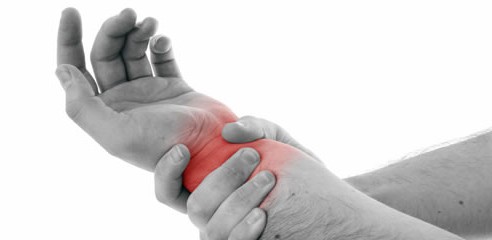
Symptoms and diagnosis of the disease
As a rule, the patient learns about the existence of hygroma when it appears outside the joint capsule. Determined by palpation. This is a round-shaped growth that may be quite soft at first, but becomes harder over time.
The hygroma moves freely under the skin, but has an attached base. It takes quite a long time to develop, sometimes this process can last for years. The sizes also depend on the neglect of the case, ranging from the size of a small pea to 10 cm in diameter. The larger the size it reaches, the more noticeable the discomfort and the higher the danger. Also, when the hygroma is large, it begins to compress the tissues and nerve endings that are around it and thereby causes pain.
They will conduct additional studies: X-rays, MRI, ultrasound, and a puncture. This will allow us to understand the nature of the neoplasm and exclude such options as atheroma, lipoma, bone growths, inflammation blood vessels, aneurysm. People who have hygroma of the wrist should not despair. Treatment with folk remedies, reviews of which indicate its effectiveness, gives good results. 
Treatment methods
Three main methods are used to treat hygroma:
- Surgical. It consists of surgically removing the hygroma under local anesthesia in a medical institution. Used for large tumors.
- Conservative treatment methods. Includes puncture aspiration and physiotherapy.
- Treatment with folk remedies. It consists of treatment with herbs, berries, poultices and other similar means.
Conservative methods of treating a disease such as wrist hygroma have proven to be quite effective. Treatment without surgery involves a set of measures aimed at softening the walls of the tumor and then removing fluid from it.
Choosing a treatment method
The choice of treatment method depends on the severity of the disease and the size of the hygroma. However, the most ineffective and in a dangerous way is crushing or puncturing tumors - this is not only useless and painful, but can also provoke relapses or the addition of a secondary infection. 
These methods are effective provided early diagnosis and if it is a relatively small hygroma of the wrist. Treatment without surgery in this case will be very effective. And complete resorption of the hygroma is even possible. These methods include the aspiration procedure. Its essence lies in the fact that you need to insert a special needle into the body of the hygroma. Pumping out the pus and introducing solutions of antibiotics, antiseptics and anesthetics into the empty capsule. After the procedure, the wrist is tightly bandaged and the bandage is worn for 3-5 weeks. If the fixing bandage is removed early, relapse is possible.
Physiotherapy and electrophoresis
Another one of possible methods Physiotherapy may be the treatment. The following procedures are used: mud wraps, heating with UV rays, paraffin masks, electrophoresis using iodine. These methods are not prescribed for acute inflammation in order to avoid breakthrough of the tumor walls and leakage of pus into the arm cavity.
If a person has a hygroma of the wrist, treatment without surgery can be carried out in other ways. Reviews about the effectiveness of this treatment are mostly positive. Just keep in mind that they are used when a problem is detected early. 
Home treatment
A rather complex disease is hygroma of the wrist. Non-surgical treatment with folk remedies, reviews of the effectiveness of which are very varied, can also be used at home. Methods home treatment tumors are different. But it is important to remember that folk remedies are suitable for small sizes of hygroma, for initial stage development.
Mud therapy can also be performed at home. To do this you will need: 2 tablespoons of sea salt and 1 glass. They must be mixed with 100 ml of warm water. The resulting mass is applied to the joint for a day, periodically moisturizing with warm water. After a day, you need to let the skin air out for a couple of hours and apply the mixture to the joint again. This treatment lasts for 10 days.
Warming procedures include heating with medical alcohol, iodine or calendula tincture. A gauze pad is impregnated with any of these products and wrapped around the wrist.
Warming up with a blue lamp is good analogue UV heating in a hospital. Another reliable folk remedy is a copper coin. It is dipped in vinegar and then applied to the hygroma, wrapped tightly with a bandage. This bandage is worn for at least one month. After this period, the tumor should disappear. If a person is bothered by hygroma of the wrist, treatment without surgery (photos of the procedures will help you understand how to carry them out correctly) is possible. 
For the purpose of warming up and influencing medicinal properties plants use infusions to steam the wrist. To do this, make a decoction of pine needles. The raw materials are poured with water so as to just cover it. Boil for 20 minutes, cool to an acceptable temperature. And they steam their hands while the broth cools. After steaming, lotions are applied. They are made from ground wormwood grass, crushed cabbage leaves, celandine, Kalanchoe, and ficus.
Physalis fruits, honey and kombucha are also used for lotions. The raw material is thoroughly crushed and applied to the tumor overnight. The above recipes will help eliminate such a problem as wrist hygroma. Treatment with folk remedies gives excellent results if the disease is at early stage development.
Relapse Prevention
Regardless of what treatment methods were used, be it surgical removal, treatment conservative methods or assisted therapy traditional medicine, to prevent relapses, prevention must be carried out.
To do this you need:
- Distribute the weight evenly on both hands.
- If it is impossible to avoid stress, you must wear a fixing bandage or a special corset on your wrists.
- Perform a therapeutic set of exercises.
- If you receive an injury, be sure to consult a doctor and do not ignore the treatment regimen.
Thus, even if a relapse occurs, if wrist hygroma occurs again, treatment without surgery with folk remedies will be very effective.
Wrist hygroma is considered a very unpleasant, but not life-threatening disease, which is more common in women under 35 years of age. Moreover, men and children rarely suffer from this pathology.
What is a disease?
Hygroma is a harmless disease that can be quickly cured, however, it can recur many times. She represents benign education, the walls of which are formed of hard connective tissue. Inside, the formation is filled with serous transparent or yellowish viscous liquid mixed with fibrin.
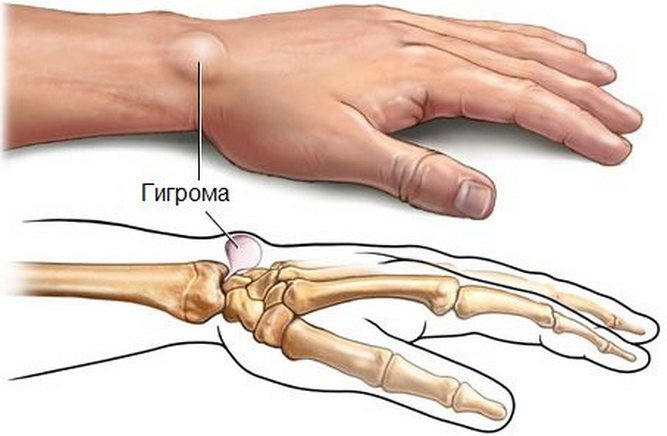
The hygroma of the wrist is oval or round shape. It is most often located in the wrist joint, and can be located both on the outer and inner sides. The peculiarity of education is that it never transforms into malignant tumor. That is why the treatment of pathology is more likely to have a cosmetic purpose.
What reasons for development exist?
The following reasons can influence the development of hygroma of the hand:
- Frequent injury to the wrist joint of the hand, after which the integrity of the tissue is somewhat compromised.
- Chronic inflammatory process, which is localized in the periarticular bursae of the wrist joint.
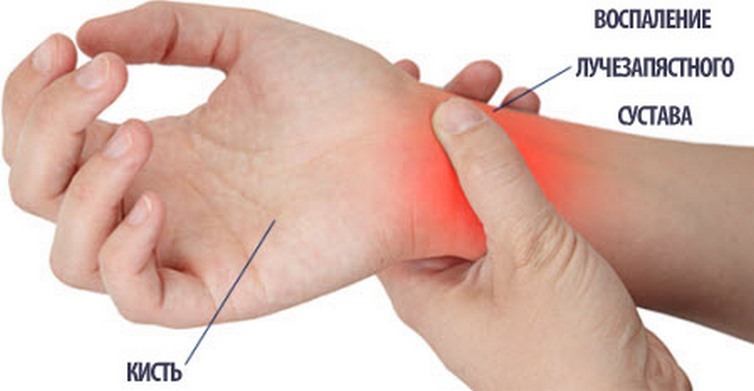
- Ligament inflammation, bursitis and other pathologies of the supporting system.
- Intense sports activities.
- Surgical intervention in the wrist joint of the hand (as a consequence).
- Professional activity: hygroma occurs after periodic long-term work at the computer. This pathology is often diagnosed in seamstresses and massage therapists.
- Untreated osteoarthritis of the wrist joint in an advanced form.
It is known that the occurrence of the disease is genetic. That is, it can be inherited from parents to children. Sometimes the causes of the disease cannot be determined.
It should be noted that hygroma of the wrist never becomes malignant, and also practically does not cause discomfort. However, in some cases it can cause pain, so treatment is still best.
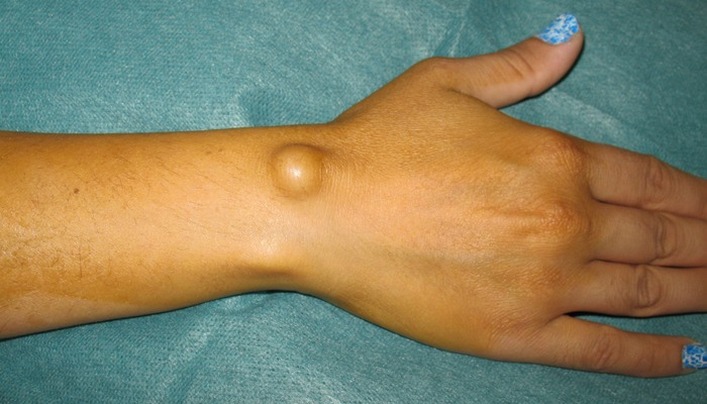
Hygroma of the wrist joint: diagnostic features
Often people who have this problem do not know which doctor they need to see. To make an accurate diagnosis, it is necessary to consult an orthopedic surgeon. The examination involves an accurate determination of the cause that provoked the disease, as well as methods by which it can be eliminated. That is, the doctor must determine the location of the tumor on the hand, after which its size and other characteristics are determined.
Laboratory tests in this case are useless (except for a biopsy). The following methods are used for diagnosis:
- CT or MRI.
- Ultrasound examination.
- In some cases, the contents of the hygroma are punctured for further morphological and cytological examination.
- Radiography.
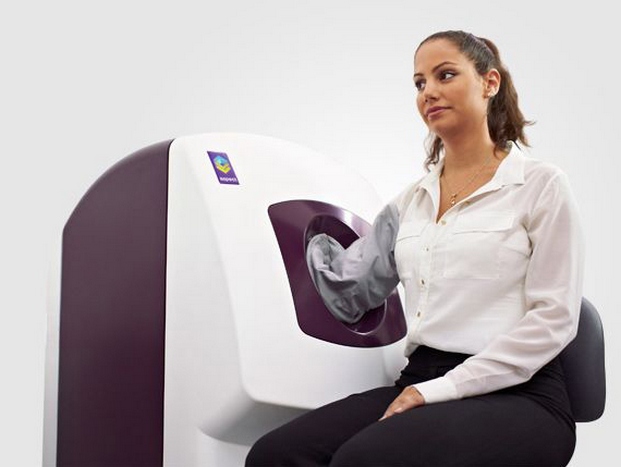
Types of disease
Hygroma located on the hand can be classified as follows:
- Mucosal hygroma of the wrist. It often appears after the development of deforming arthrosis of the wrist joint. The reason for this is the proliferation of osteophytes, which put pressure on the joint, simultaneously damaging it. For protection purposes, the body begins to build up connective tissue, from which a cyst is formed in the hand. Over time, this cavity fills with viscous liquid.
- Post-traumatic hygroma on the left or right wrist. The cause of its occurrence is considered to be damage to the joint capsule.
- Tendon ganglia. They are formed after a pathological change in the tendon sheath cells occurs. In this case, the wrist moves poorly, and the pathology causes pain.
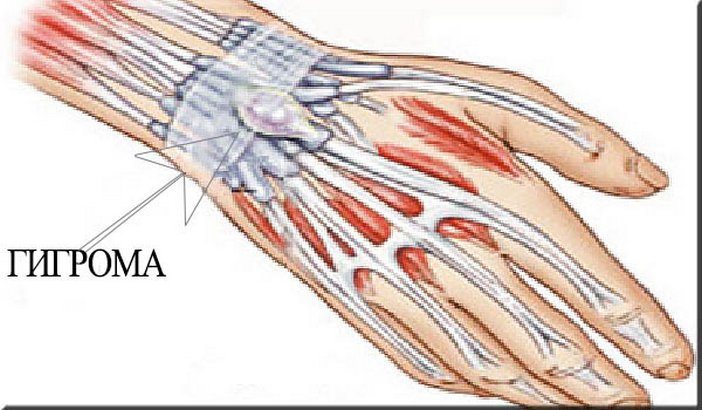
Treatment of hygroma on the hand can be done in different ways, however, it is mainly used surgical method. Unfortunately, it is not able to prevent the recurrence of the formation.
Symptoms, signs and consequences of pathology
Hygroma of the wrist joint is a kind of lump on the wrist, which sometimes hurts and leads to impaired mobility of the joint. But treatment is often performed to eliminate internal discomfort.
Wrist hygroma has the following characteristics:
- It feels elastic and soft to the touch.
- Although the neoplasm is not very mobile, the skin above it moves well.
- The temperature in the area of the wrist joint does not change, skin has a normal color.
- Hygroma, located on the hand, has clear boundaries and certain dimensions.
- After its appearance, the formation may grow, and the patient feels coldness in the hands and their numbness.
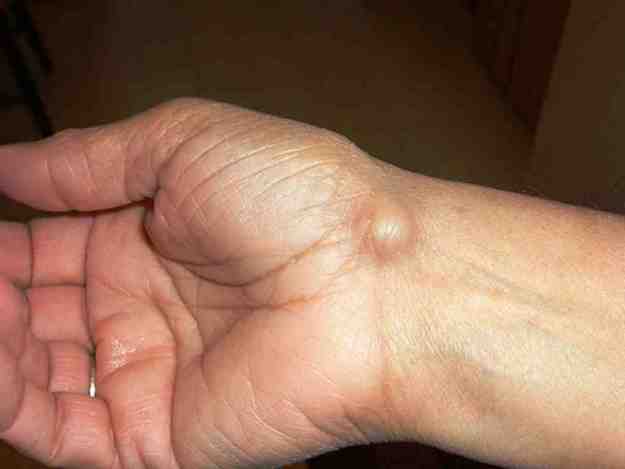
Consequences of pathology
So, what a hygroma of the wrist is is already known. Now we need to consider what consequences arise after its appearance. In general, the presented cyst is not life-threatening as long as it is intact. But if it is accidentally crushed, a wound will appear that is susceptible to infection, as a result of which suppuration may develop.
It is not easy to get rid of formations that are located near large vessels. There is a risk of arterial damage. Therefore, the operation must be performed extremely carefully. This is especially important if the disease appears in a child.
Features of treatment of the disease
If your wrist hurts, then to get rid of discomfort, it is necessary to immobilize the limb. For this purpose it is used elastic bandage, splint or splint. Exacerbation of the pathology, in which severe pain is felt in the wrist, can be treated with the help of drugs such as Ketorolac, Ibuprofen. If the disease appears in a child, then it must be treated with the utmost care. The operation is rarely performed on children.
If your hand hurts, goes numb and is limited in movement, and the formation itself has greatly increased in size, you should definitely go to the doctor. In this case, surgery will be required to remove the hygroma. Although in most cases, even after this procedure, the cyst may appear again, and again you have to consult a doctor.
The operation is not complicated. Now you can find and view photos and even videos of it. The intervention involves removing fluid from the cyst cavity using a special needle. All surgical procedures are performed under local anesthesia. After the procedure, the formation cavity must be washed with an antiseptic solution. If a hygroma of the wrist joint was removed and pus was discovered during the operation, then after the intervention an antibiotic is injected into the cavity of the formation.
After the intervention, a fixing bandage or orthosis is applied to the wrist. It's filming in a few weeks. If you do this prematurely, the hygroma may soon appear again.
Both children and adults will benefit from physical therapy. There are good reviews about mud therapy and ultraviolet therapy. If the tumor is small and does not hurt, then it can be treated with hot paraffin baths and electrophoresis using iodine.
The indication for surgical intervention is the uneven cellular structure of the formation, as well as its too large size. The operation involves complete removal of the hygroma along with its capsule. Photos and videos of this procedure can also be found and viewed on the Internet.

Laser surgery is considered safer. It is less traumatic for the wrist. In addition to removing the formation with a laser, you can use an endoscopy procedure. Price surgical intervention on average is about 12,000 rubles.
Traditional treatment
Treatment of a child, as well as an adult, can be done with folk remedies. Moreover, you can prepare not only decoctions, but also ointments at home. The following recipes received good reviews:
- Kombucha. Compresses are made on its basis and applied to the affected area.
- Tincture of calendula or iodine. This product lubricates the hygroma.
- Wormwood grass. A kind of ointment is made from it. The raw grass should be thoroughly crushed, applied to the wrist and wrapped with a bandage. You should keep this compress all night.
- Kalanchoe and aloe leaves. You can simply attach them to your hand, wrap them with film and a warm scarf.
![]()
- Decoction of pine branches. To prepare the solution you need 2 kg of raw materials. It should be filled with water and boiled for at least 20 minutes. Next, the liquid should be poured into another container and cooled to 37 degrees. After this, it is advisable to lower the affected hand into the prepared “bath”. It must be kept for at least 15 minutes.
- Alcohol compress. He also has good reviews. To prepare it you need to take 2 parts alcohol and 1 part water. Combine these components, soak a piece of gauze in the mixture, apply it to the tumor and secure with a bandage. Next, the wrist is wrapped with polyethylene and warm soft cloth. You need to keep the compress for at least two hours. In this case, it is better to keep the brush motionless. The procedure is repeated every 48 hours.
The course of treatment usually lasts 10 days. Folk remedies are used to treat hygroma of the wrist joint only if it does not hurt and does not limit the movement of the limb.
Prevention of pathology
Wrist hygroma, treatment has already been discussed, is a harmless pathology. However, it is unpleasant, as it worsens appearance wrists, and improper treatment can cause complications. Therefore, it is better to prevent the disease. To do this, you need to follow the following recommendations:
- It is necessary to prevent any sports, household or work injuries to the wrist.
- If a person needs to go to training, then he should first protect the wrist with the help of special fixing orthopedic devices.
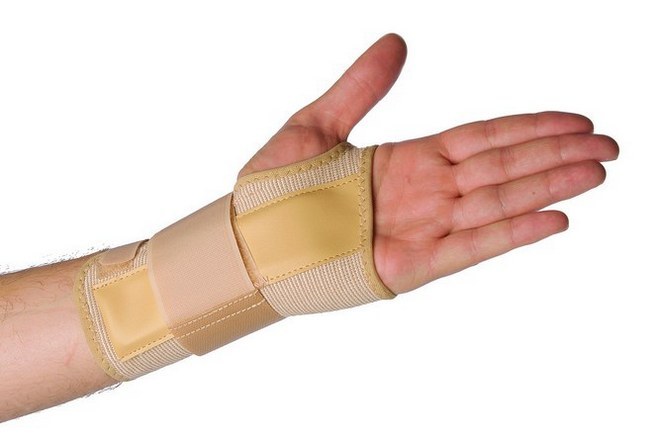
- If the wrist joint has been damaged, you should immediately consult a doctor who will determine treatment options. However, the recommendations received cannot be ignored.
- We need to deal with it in a timely manner inflammatory pathologies articulations.
- An optimally planned work and rest schedule will help avoid excessive physical strain on the wrist.
- If a person has a genetic tendency to develop such formations, then he should not choose those areas of activity that require DC voltage brushes or monotonous hand work.
- Light gymnastics, which only strengthens the joints, will be useful.
These are all the features of the presented pathology. Be healthy!
